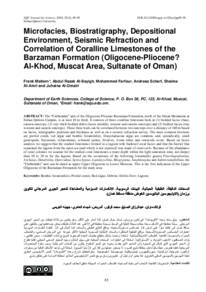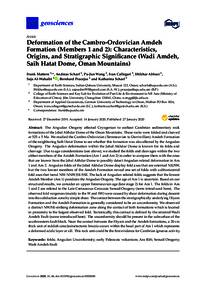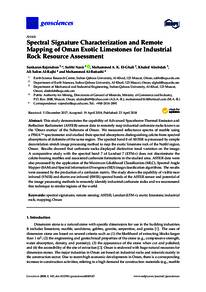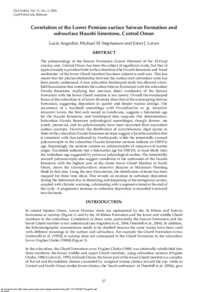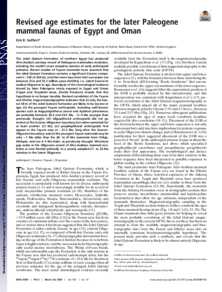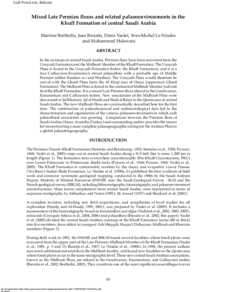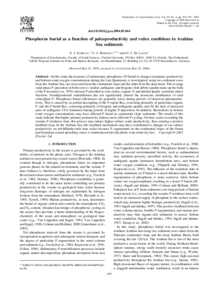وثيقة
Microfacies, biostratigraphy, depositional environment, seismic refraction and correlation of coralline limestones of the barzaman formation (oligocene-pliocene? : Al-Khod, Muscat area, Sultanate of Oman).
المعرف
DOI:10.24200/squjs.vol25iss2pp85-99
المصدر
Sultan Qaboos University Journal for Science. v. 25, no. 2, p. 85-99.
المساهمون
Al-Sayigh, Abdul Razak., مؤلف
Farfour, Mohammed., مؤلف
Scharf, Andreas., مؤلف
Al-Amriyah, Shaima., مؤلف
Al-Omairiyah, Juhaina., مؤلف
عناوين أخرى
السحنات الدقيقة، الطبقية الحياتية، البيئات الرسوبية، الانكسارات السيزمية والمضاهاة للحجر الجيري المرجاني لتكوين برزمان (الاوليجوسين الباليوسين الخوض منطقة مسقط عمان).
الدولة
Oman.
مكان النشر
Muscat
الناشر
College of Science, Sultan Qaboos University.
ميلادي
2021-05-23
اللغة
الأنجليزية
الموضوع
الملخص الإنجليزي
The “Carbonates” unit of the Oligocene-Pliocene Barzaman Formation, north of the Oman Mountains at Sultan Qaboos Campus, is at least 10 m thick. It consists of three coralline limestone beds in (1) bedded facies (base; eastern outcrop), (2) very thick-bedded debris facies (middle; western and eastern outcrops) and (3) bedded facies (top; western and eastern outcrops). These three beds can be correlated between two outcrops over a distance of 160 m based on facies, stratigraphic positions and thickness as well as on a seismic refraction survey. The most common bioclasts are poritid corals, red algae and benthic foraminifers. Dasycladacean algae are common, and, sporadically, small gastropods, bryozoans, echinoderms, echinoid spines, bivalves, worm tubes and ostracods occur. Based on facies analysis we suggest that the studied limestones formed in a lagoon with backreef coral facies and that the barrier that separated the lagoon from the open sea (and which is not exposed) was made of coral reefs. Because of the abundance of coral colonies we assume for the studied coral limestones a water depth within the light saturation zone, not deeper than 10 to 20 m for the lagoon. Based on the occurrence of the following foraminifer genera Praerhapydionina, Archaias, Dendritina, Operculina, Spiroclypeus, Lepidocyclina, Miogypsina, Amphistegina and Subterraniphyllum, the “Carbonates” unit can be dated as upper Upper Oligocene to Lower Miocene. This is the first indication of the Upper Oligocene of the Barzaman Formation for the study area.
ISSN
2414-536 X
الملخص العربي
تبلغ سماكة وحدة "الكربونات" من تكوين برزمان الأوليجوسيني-بليوسيني، الواقعة شمال جبال عمان في حرم السلطان قابوس، 10 أمتار على الأقل. وتتكون من ثلاث طبقات من الحجر الجيري المرجاني في (1) واجهات طبقية (القاعدة؛ النتوء الشرقي)، (2) واجهات حطامية سميكة للغاية (الوسطى؛ النتوءات الغربية والشرقية) و(3) واجهات طبقية (العلوية؛ النتوءات الغربية والشرقية). يمكن ربط هذه الطبقات الثلاث بين نتوءين على مسافة 160 مترًا بناءً على الواجهات والمواقع الطبقية والسمك بالإضافة إلى مسح الانكسار الزلزالي. أكثر أنواع الحطام الحيوي شيوعًا هي المرجان البوريتيدي والطحالب الحمراء والفورامينيفرات القاعية. تنتشر الطحالب الدايسيكلادية، وتوجد بشكل متقطع بطنيات القدم الصغيرة، والطحالب، وشوكيات الجلد، وشوكيات القنفذ، والرخويات، وأنابيب الديدان، والصدفيات. واستنادًا إلى تحليل الوجوه، نقترح أن الحجر الجيري المدروس تشكل في بحيرة ذات وجوه مرجانية خلفية وأن الحاجز الذي يفصل البحيرة عن البحر المفتوح (والذي ليس مكشوفًا) كان مصنوعًا من الشعاب المرجانية. ونظرًا لوفرة مستعمرات المرجان، فإننا نفترض أن عمق المياه في الحجر الجيري المرجاني المدروس يقع ضمن منطقة تشبع الضوء، ولا يزيد عن 10 إلى 20 مترًا بالنسبة للبحيرة. بناءً على وجود أجناس الفورامينيفر التالية Praerhapydionina و Archaias و Dendritina و Operculina و Spiroclypeus و Lepidocyclina و Miogypsina و Amphistegina و Subterraniphyllum ، يمكن تأريخ وحدة "الكربونات" على أنها تعود إلى العصر الأوليغوسيني العلوي إلى العصر الميوسيني السفلي. وهذا هو أول مؤشر على العصر الأوليغوسيني العلوي لتكوين بارزامان لمنطقة الدراسة.
قالب العنصر
مقالات الدوريات

